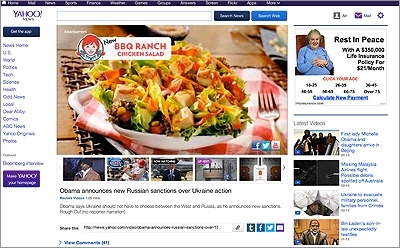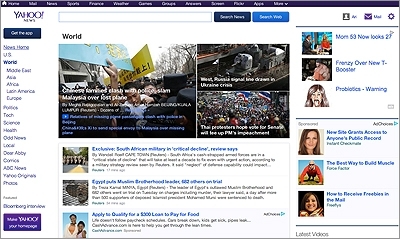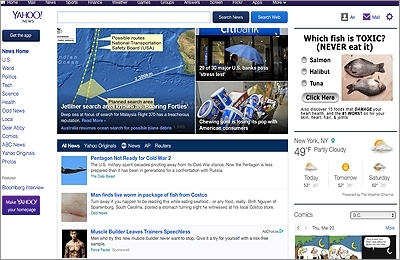Commentary
Yahoo Has Become A Litter Box For Online Advertising
- by Ari Rosenberg , Op-Ed Contributor, March 27, 2014
Venture-capital-fueled ad tech companies have convinced traditional publishing companies with rich and successful histories of selling advertising, that they no longer know how selling advertising works. The ad-tech collective calling card reads, “This new way is way better than your old way.”
Better for whom?
Media buyers and sellers don’t line up on the same side of the field. Their financial goals are diametrically opposed. One wants lower prices, one wants them higher. This “right price” the tech stack proclaims to deliver to publishers is a euphemism for “it’s more than nothing, but much lower than what you get the old way. But hey, look, no paper work.”
advertisement
advertisement
At a recent programmatic conference, a moderator challenged a panel of programmatic buyers and sellers by stating that while programmatic CPMs are rising, they are significantly below CPMs secured by salespeople selling directly. One panelist, a director for a trading desk, responded, “Well maybe those prices were too high to begin with.” The panel nodded in agreement.
Say what?
That’s not how it works. That’s not how any of this works.
Premium publishers built their businesses by obtaining premium prices, and are now buying into ad tech that makes it easier to buy their product at lower prices. This combination produces revenue from what would otherwise be unsold product -- no argument there. However, it also produces something site visitors and media buyers notice, but premium publishers are ignoring: shitty-looking ad creative on their sites.
I see these ads all the time on premium sites, but the premium site I spend the most time on is Yahoo (my business email lives there). Yahoo, a leader in the online display ad space and a heavy proponent of programmatic, has become a litter box for online ads.
As a user, Yahoo services my email hosting needs adequately. When I venture out to its content, however, it could care less about my needs. That’s when I get hit with video pre-roll ads that auto-play as soon as I land on the page, home page rectangles that auto-expand like pop-ups, fake content galore, and an ad/edit ratio on my above-the-fold page view that makes me dizzy. Yahoo also has a suspicious tendency of asking me to re-log in three or four times consecutively, often on Fridays, and each time serving up full-page log-in ads I suspect are underdelivering that week.
Then, thanks to programmatic, Yahoo serves users the cheapest looking ad creative imaginable. And the company wonders why its premium direct sales business is suffering.



That’s not how it works, that’s not how any of this works.
What Yahoo and other publishers racing into programmatic ignore is that ads are part of the user experience, and the perceived value of this experience is affected by the quality of the creative. In turn, buyers and clients who see inferior ad creative running on premium sites see less value in buying that site.
Many will dismiss my claims as naïve or out of touch with today’s market. After all, money is flowing, but CPMs have been dropping for years. That is not how publishing should work, that’s not how any of this is supposed to work.
If you have a chance, pick up the most recent issue of Harper’s Bazaar. You will see over 60 ad pages before you even get to the magazine’s table of contents. These ads are as beautiful as the magazine itself, and no one ever clicks on them. Instead, readers trace them seductively with their thumb and forefinger while fantasizing about owning what is being sold.
That’s how this thing works.
We are so far from “that.” The smell from this collective online ad litter box (not just Yahoo’s) will keep brand dollars away until we scoop out the shitty ads. For that to happen, premium publishers need to remove the sign they just hung that reads, “All ads welcome,” and replace it with a velvet rope inducing clients to dress well enough, and pay more, to enter. Only then will we see quality ad creative that enhances the value of a site. A cheap entrance equals cheaper suits; a high cover charge causes lines of people dressed to the nines.
Getting back to how it’s supposed to work requires a publishing leader to rise up and show us the way back home. Sadly, I don’t see that happening.



Well put. Our model is to only work with a handful of brands at one time. They pay to reach our audience, but we deliver quality messaging for them. We never accept 3rd party ads and don't belong to any ad networks. It is a downward spiral to irrelevancy
Agreed with everything in here, except that Yahoo Mail serves anyone's email needs adequately.
Amen, Ari!
Bravo! Viewers will continue to ignore bad creative and won't touch the litter box. How much stench can we tolerate? Wake up publishers and advertisers and start scooping it out.
“The ad-tech collective calling card reads, ‘This new way is way better than your old way.’”
Yes, adtech it trying to create more efficiencies in the marketplace and those iterations are "new" but you can't forget that the industry is STILL stuck on the 40k Flash banner as the default standard for Display. This is a spec from 1998 that was originally created to serve the needs of dail-up users. Now, Flash ads are on average failing 15 to 20 percent of the time yet the parade marches on. 99.9% of mobile impressions serve a static JPG. The first banner was in 1994 and that was a JPG so we're actually as an industry deploying 20 year old tech into the best inventory. I'm not so sure all these VC backed companies are convincing anyone of much.
"Better for whom?", you ask?
Well, better for everyone if you actually want your ad to perform because it's properly targeted, not failover, and if you'd like that placement to be visible and affordable.
As far as the quality of the creative we've put affordable multiscreen video on the table but the inertia of the marketplace and overall cynicism from buyer keeps so many from trying "new things". Until then you'll just keep seeing these crappy looking ads... as long as you're on a desktop browser with Flash installed. Otherwise, you'll just see a static image.
Great piece here. My personal email is on Yahoo! (it's a 10+ year old account) and I always wondered why I'm sometimes mysteriously logged out of it. I assumed it was either a security precaution, or that web devs making updates had wiped away everyone's session cookies/IDs. But under-delivery on splashy login creative makes a lot of sense. However, on the other hand, Yahoo's mobile web email (not the app, which I found to be barely functional) is horrendous, which then takes me back to the theory that these "mystery logouts" are simply the result of sloppy dev work. We may never know...
For years, the advertising industry suffered from an over abundance of people with some sort of a college education that had absolutely no relevance to knowing and understanding what good advertising is. This was compounded by having a plethora of very talented artists who mistakenly believed that if you know how to draw a circle then you know how to create an effective print ad. Along with them you had people who were charged with the responsibility of driving product sales, yet they knew nothing about how to sell a product. And then, of course, you had the media buyers who made buys based upon a list of criteria that was compiled by a media director who was out of touch with the latest trends and technologies: these media directors were typically the last people to get color TV, FM radios, cable TV service, and then Internet connectivity. If any of this sounds familiar it's becasue I spent 40-plus years in the industry (and I'm as active today as ever).
So all of this was bad enough, but then came Internet advertising. I can't tell you how many panels I served on at new media conferences that had speakers telling the audience that "everything has changed." You know, highly qualified people like those from Enron and Quokka and eToys and CarsDirect - all the great successes - talking about how black is now white, white is now green, and profits don't matter. Of course, these were all people who literally did not know their Yahs from their Hoos, and profits didn't matter to them as long as they still had millions of dollars of investors' money to burn.
The above story written by Ari Rosenberg is very true, but it may actually not be critical enough of what is going on and how AOL, MSN, Yahoo, and now Google are destroying many peoples' hard work. Efforts to make search results more relevant have blocked the free flow of information. For example, I may be interested in dogs, but when I visit a website about baseball I don't want to be inundated with overt and covert ads about dogs. If I want dogs I'll go to a website about dogs or enter the word dogs in the Google search bar.
However, let me end on a positive note: At least the new, very young Yahoo CEO did one thing, she had the company design a new logo (whether the needed it or not). I'm sure that when the final chapter is written about Yahoo that the defining moment of their history will be this change of logo.
What I forgot to add is that as a website publisher, I want my audience to see ads that are relevant to my content category. I want ads to show up that have a high degree of probability to be clicked. Unless and until an advertisers is willing to pay a premium rate to display their "institutional" ad, I don't want those advertisements on my website.
Great content and great writing.
Well said Ari.
Funny, there was a time when an advertiser would peruse a magazine to see who the other advertisers were as part of their assessment of whether it was the "right environment" for their own ads.
...thus the ascension of "premium programmatic"
Sorry for the delayed response I was away for the weekend after this column ran -- I really appreciate all of the supportive feedback -- I recognize I am not the only one fed up with what is transpiring before our very eyes -- thanks again.
Ari